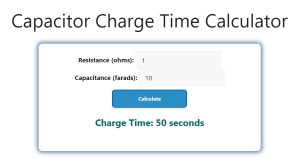About Capacitor Charge Time Calculator (Formula)
The Capacitor Charge Time Calculator is a vital tool for electrical engineers and technicians working with capacitors in various circuits. Understanding the time it takes for a capacitor to charge is essential for circuit design and analysis, particularly in timing applications, filters, and power supply circuits. This article will explain the formula used in the Capacitor Charge Time Calculator, provide a step-by-step guide on how to use it, present an example calculation, and answer frequently asked questions.
Formula
The formula for calculating the charge time of a capacitor is:
T = R * C * 5
In this formula:
- T represents the charge time in seconds.
- R is the resistance in ohms (Ω).
- C is the capacitance in farads (F).
The factor of 5 is used to estimate the time it takes for the capacitor to charge to approximately 99% of its maximum voltage.
How to Use
Using the Capacitor Charge Time Calculator is a straightforward process. Follow these steps:
- Determine Resistance (R): Measure or determine the resistance in the circuit where the capacitor is connected.
- Determine Capacitance (C): Measure or identify the capacitance of the capacitor.
- Input the Values: Enter the values of resistance (R) and capacitance (C) into the calculator.
- Calculate Charge Time: Click the calculate button to find the charge time for your capacitor.
Example
Let’s illustrate how to use the Capacitor Charge Time Calculator with a practical example:
- Values:
- Resistance (R): 1000 ohms (1 kΩ)
- Capacitance (C): 0.01 farads (10 mF)
- Using the Formula:
T = R * C * 5
T = 1000 * 0.01 * 5
T = 50 seconds
In this example, the charge time for the capacitor is 50 seconds.

FAQs
- What is capacitor charge time?
Capacitor charge time is the time required for a capacitor to charge to a specific voltage in a circuit. - Why is the factor of 5 used in the formula?
The factor of 5 is an approximation to estimate the time it takes for the capacitor to charge to about 99% of the supply voltage. - Can I use this calculator for different types of capacitors?
Yes, the calculator can be used for various types of capacitors as long as you know the resistance and capacitance values. - What happens if I increase the resistance?
Increasing the resistance will result in a longer charge time for the capacitor. - What if I change the capacitance value?
Increasing the capacitance will also increase the charge time, while decreasing it will reduce the charge time. - What units are used for resistance and capacitance?
Resistance is measured in ohms (Ω) and capacitance is measured in farads (F). - Can I use this calculator for AC circuits?
This calculator is primarily designed for DC circuits; AC circuits require more complex calculations due to varying voltage and current. - How do I find the maximum voltage of a capacitor?
The maximum voltage of a capacitor is usually specified on the capacitor itself and is known as the rated voltage. - What is the significance of charge time in circuits?
Charge time is important for understanding how quickly a capacitor can store energy, affecting the overall performance of the circuit. - How does temperature affect capacitor charge time?
Temperature can affect the resistance and capacitance values, potentially altering the charge time. - Can I use the calculator for multiple capacitors in series?
For capacitors in series, you will need to calculate the equivalent capacitance before using the calculator. - What is the difference between charge time and discharge time?
Charge time refers to how long it takes for a capacitor to fill with charge, while discharge time is how long it takes for the capacitor to release that charge. - How can I reduce the charge time of a capacitor?
You can reduce the charge time by decreasing the resistance in the circuit or using a capacitor with a smaller capacitance. - What happens if the resistance is too low?
If the resistance is too low, it could lead to a rapid charge that might damage the capacitor or the circuit components. - Are there applications where charge time is critical?
Yes, applications such as timing circuits, flash photography, and power supply stabilization rely heavily on precise charge times. - Is the charge time affected by the voltage applied?
The formula does not directly consider voltage; however, higher voltages can increase current and may affect charge dynamics. - Can this calculator be used in simulations?
Yes, many circuit simulation tools allow you to incorporate charge time calculations for analysis. - How do I measure the actual charge time in a circuit?
You can measure charge time using an oscilloscope to observe the voltage across the capacitor as it charges. - What are some common mistakes when calculating charge time?
Common mistakes include incorrect resistance or capacitance values, forgetting to convert units, or misapplying the formula. - Where can I learn more about capacitor applications?
There are many online resources, textbooks, and courses available that cover capacitor applications and circuit design principles.
Conclusion
The Capacitor Charge Time Calculator is an essential tool for anyone involved in electrical engineering and circuit analysis. By simplifying the process of calculating charge time using resistance and capacitance values, users can quickly analyze circuit behavior and design efficient systems. Understanding capacitor charge time not only aids in circuit analysis but also enhances overall circuit performance, making it a crucial concept in electrical engineering.